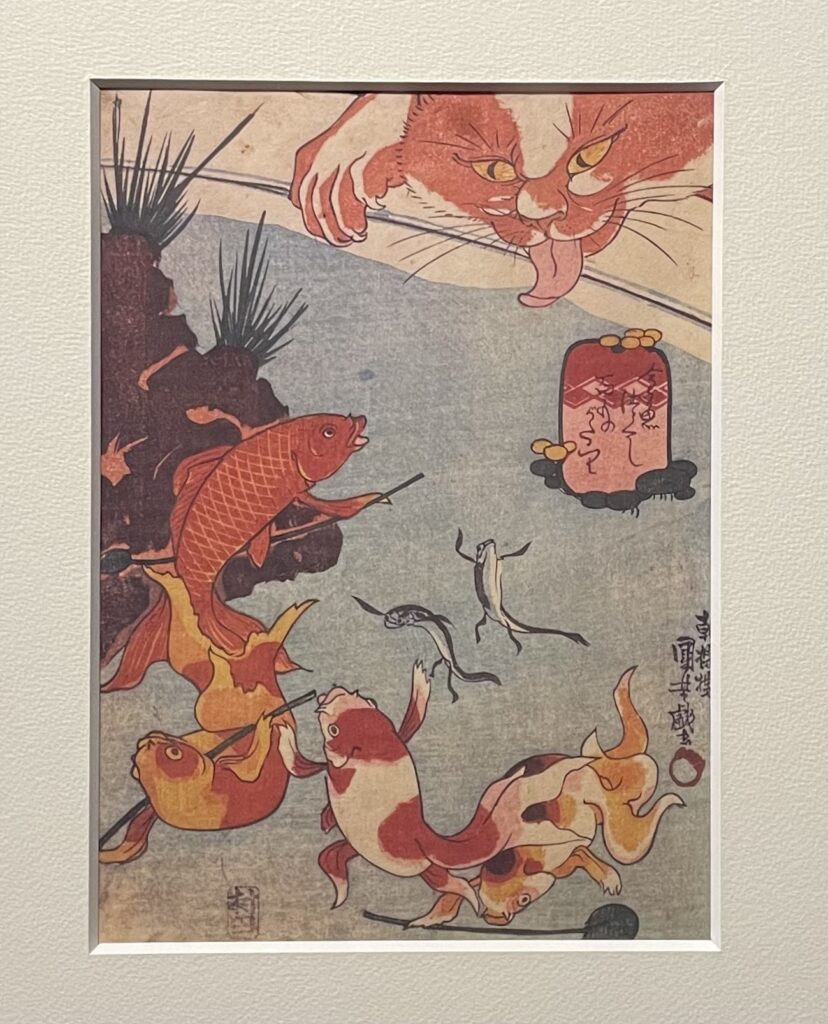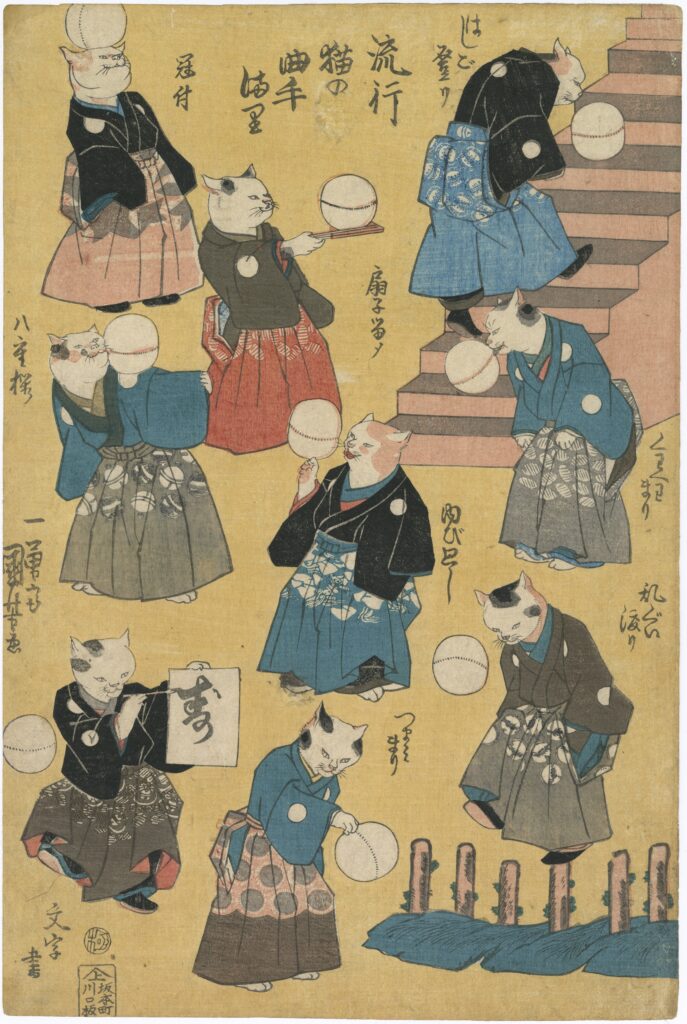浮世絵 猫
金魚づくし 百ものがたり
Series “Goldfish Miscellany”:Hyakumonogatari

人気の作品シリーズ“金魚づくし”にも、金魚と猫の共演をみることができます。怪談会を楽しむ金魚たちを脅かす猫の表情がとてもいじわるに見えます。ひっくり返っている金魚や、逃げ惑う金魚、なかには勇敢に立ち向かおうとする金魚もいて、一人一人の動作が面白く描かれています。
You can also see goldfish and cats co-starring in the popular series "Kingyo Zukushi."The cat's expression looks very malicious as it threatens the goldfish who are enjoying the ghost story. There are goldfish flipping over, goldfish running away, and some goldfish bravely trying to fight back, and the movements of each individual are depicted in an interesting way.
.
其まま地口 猫飼好五十三疋
Cats Suggested as the 53 Post-Stations Towns Along Tokaido

“地口”とは語呂合わせという意味。東海道五十三次の各宿場を猫の仕草に関連付けた語呂合わせで表現した、国芳のアイデアあふれる作品。表記された宿場名と一言からどんな“地口”になっているか考えながら鑑賞してみてください。
「三島」には、“三毛ま”と記され、手ぬぐいをかぶって踊る三毛猫が。この猫、よく見るとしっぽが二又に分かれた妖怪“猫又”であることがわかります。三毛の猫又で、“三毛ま”→三島 という地口です。この手ぬぐいをかぶって踊る猫又、他の作品にも描かれているのでぜひ探してみてください。
“Jiguchi” is a play on words. This work is full of ideas, expressing each of the 53 stations of the Tokaido with puns associated with cat gestures.
In ``Mishima,'' a calico cat wearing a tenugui is dancing. If you look closely, you will see that this cat is a monster called a nekomata with a forked tail. Nekomata dancing while holding a tenugui are also depicted in other works, so be sure to look for them.
.
昔ばなしの戯猫又年とへて古寺に怪をなす図
Playful Old Tales: An Old Cat Changing into a Monster at an Old Temple

江戸時代後期から流行した歌舞伎の演目、「猫騒動物(ねこそうどうもの)」。古くは今川家のお家騒動に怪猫を組み合わせた人形浄瑠璃があり、お家騒動にからめて怪猫のたたりが描かれるようになりました。本作もまさに、猫又という猫の妖怪が、鉄漿(おはぐろ)の老婆の幽霊とともに、寺西閑西と因幡之助の前に現れる場面を描いた作品。本性を表す怪猫を、三枚にわたって連ねる大胆な手法によりダイナミックに表現しています。
“Nekosoudoumono” is a Kabuki play that was popular from the late Edo period. In ancient times, there was a ningyo joruri that combined the Imagawa family's household disturbances and bakeneko, and the curse of the bakeneko also came to be depicted in connection with household disturbances. This work depicts a scene in which a cat monster called Nekomata and the ghost of an old woman named Ohaguro appear. The true nature of the monster cat is dynamically expressed through a bold technique that connects three pictures.
.
流行猫の曲手まり
Cat juggler with a Ball

擬人化された猫が様々な曲手まりの芸を披露しています。それぞれの芸は、右上から「はしご登り」「くわへまり」「乱ぐい渡り」「扇子留メ」「ゆび廻し」「つまみまり」「冠付」「八重桜」「文字書」を描いています。着物にも注目してみると、鈴や小判など、猫に関連付けた柄が描かれています。鞠を使った芸を披露する猫たちの表情や仕草までもが愉快な作品です。An anthropomorphic cat performs various tricks using a ball.If you look at the kimono, you will see patterns related to cats, such as bells and coins.The expressions and gestures of the cats performing tricks with the ball are also heart-warming.
.
猫の当字 ふぐ
“Fugu(Blowfish)”in Cat Letters

何匹かの猫を重ねて文字を形成する「猫の当字」というシリーズ作品。本作“ふぐ”は、猫たちと、ふぐ自身が重なり合い、ふぐ(具)という文字になっています。コロン、とした猫のシルエットや、しかめっ面に見えるふぐの表情など、細かいところまで生き物たちの仕草・表情が魅力的に描かれています。
The “Neko no Atezi'' series creates letters by layering several cats. In this work, the words "cat" and "blowfish" overlap to form the word "fugu".The gestures and facial expressions of the creatures, such as the silhouette of a cat and the frowning face of a puffer fish, are drawn in fascinating detail.
.
おぼろ月猫の盛 Entertainment Under a Hazy Moon
猫の左仮 Neko no Sakari

天保の改革の余波がある制作当時、遊里の情景をそのまま描くことは難しかったため、国芳は擬人化された猫たちでその様子を表現しました。「おぼろ月猫の盛」では江戸の遊郭が描かれ、「猫の左仮」では賑やかな宴会の様子が描かれています。「猫の左仮」では、画面右の浴衣を着た男猫と画面左の芸者猫が手を動かし、挙遊び(けんあそび)をしているようです。頭の黒ブチが髪型のように見える、それぞれの猫たちの表情にも注目です。
Immediately after the Tenpo Reforms, it was difficult to depict the true appearance of the red light district, so Kuniyoshi used anthropomorphic cats to depict the scene. “Oborozuki Neko no Mori'' depicts a red-light district in Edo, and ``Neko no Sakari'' depicts a lively banquet. In "Neko no Sakari" a male cat wearing a yukata on the right side of the screen and a geisha cat on the left appear to be playing with their hands. Also notice the facial expressions of each cat, with the black spots on their heads looking like hairstyles.